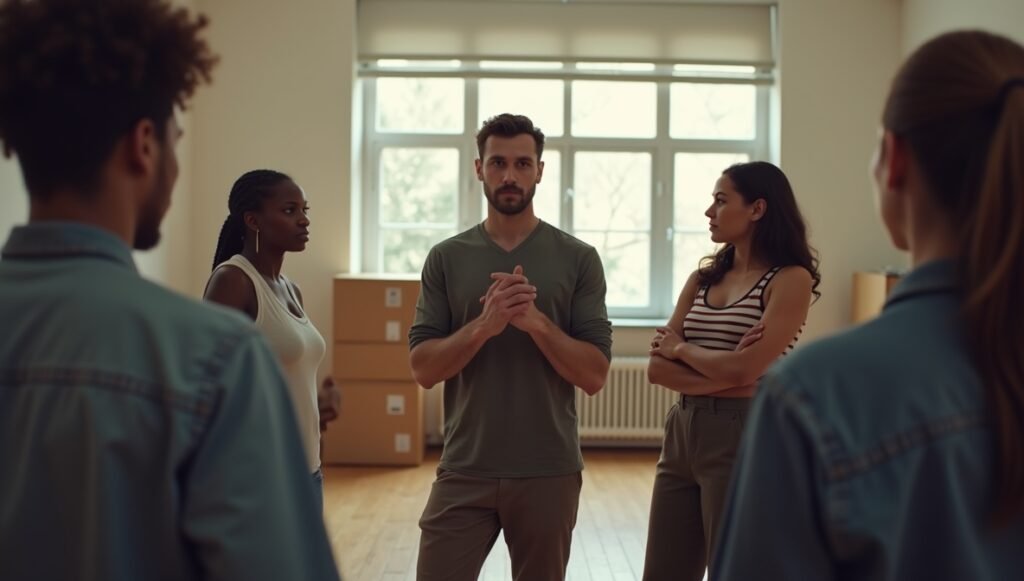Acting may look like pure talent on stage or screen, but what you actually see is the result of trainable skills practiced day after day in classrooms and rehearsal halls. Whether you dream of Broadway, blockbuster films, or simply want stronger presentation skills at work, your first term in a structured acting program will build a rock-solid foundation.
Below you’ll find a comprehensive guide—free of jargon and hype—covering the 15 core competencies most conservatories and reputable studios teach in their introductory curriculum. Use it as a preview of what to expect, a checklist for choosing the right school, or a refresher if you’ve already enrolled.
1. Breath Control & Voice Support

What It Is
Breath control refers to managing inhalation and exhalation so your voice stays strong, flexible, and free of strain. Voice support harnesses diaphragmatic breathing to project sound without shouting.
Why It Matters
An actor’s voice must reach the back row of a 500-seat theatre and sound natural in a whisper close-up on camera. Proper breath support prevents vocal fatigue, enhances emotional nuance, and protects your instrument for a long career.
What You’ll Do in Class
- Diaphragm-focused breathing cycles lying on the floor
- “S-h-h” and “ha” pulses to feel abdominal engagement
- Sustained vowel work to lengthen airflow
- Gradual volume ladders—whisper to full projection
Quick At-Home Drills
Lie on your back with a book on your belly. Inhale through the nose, letting the book rise. Exhale on a steady “zzzz” for as long as possible without wavering. Repeat ten times daily.
2. Articulation & Diction

What It Is
Articulation is the clarity with which you shape consonants; diction concerns the crisp delivery of words and phrases.
Why It Matters
Clear speech ensures the audience understands every line, regardless of dialect or speed. It also boosts confidence in meetings, auditions, and voice-over work.
What You’ll Do in Class
- Tongue-twister “speed/clarity” races
- Consonant substitution drills (“bibble babble” for B sounds)
- International Phonetic Alphabet (IPA) basics for accent work
- Reading scenes with corks between teeth to exaggerate mouth shaping
Quick At-Home Drills
Spend five minutes reciting the classic “Peter Piper” tongue-twister three ways: slowly with exaggerated consonants, at natural speed, then double-time while staying clear.
3. Body Awareness & Physicality

What It Is
Body awareness is the conscious perception of posture, alignment, and movement patterns. Physicality translates that awareness into purposeful action that communicates character.
Why It Matters
A slouched stance can signal defeat, while an open rib cage suggests confidence—all before you speak a word. Actors who master physical storytelling captivate audiences visually and support truthful performance.
What You’ll Do in Class
- Alexander Technique or Feldenkrais exercises to release habitual tension
- Neutral-mask work to discover a “zero” starting point
- Animal studies—walking, crouching, or prowling like creatures to expand movement vocabulary
- Mirror drills to identify asymmetries
Quick At-Home Drills
Set a timer for 10 minutes. Walk your living room as if your skeleton were made of liquid mercury—fluid, weightless, continuously shifting. Notice where rigidity sneaks in and let it melt.
4. Relaxation & Release of Tension

What It Is
Relaxation for actors means eliminating unnecessary muscular tension so impulses flow freely. It’s not laziness; it’s availability.
Why It Matters
Tension masks authentic emotion and restricts vocal range. Audiences sense when an actor is “tight.” Learning release techniques keeps performances spontaneous and sustainable during long runs.
What You’ll Do in Class
- Progressive muscle relaxation while seated or lying down
- Guided imagery to calm the nervous system
- Yoga-inspired stretching sequences
- Tension “check-ins” during scene work—pausing to scan jaw, shoulders, and hips
Quick At-Home Drills
Before bed, do a head-to-toe body scan. Clench each muscle group for three seconds, release on an exhale, and silently label the feeling (warm, heavy, light).
5. Imagination & Creative Play

What It Is
Imagination fuels the make-believe engine. Creative play rekindles childlike spontaneity and willingness to explore.
Why It Matters
Scripts only describe the skeleton of a world; actors’ imaginative choices bring flesh and color. Directors love performers who generate vivid possibilities instead of waiting for instructions.
What You’ll Do in Class
- “Yes, and” storytelling circles
- Object transformation—using imaginary props with sensory detail
- Guided daydream meditations (“You’re walking through a cloud forest…”)
- Free-form movement to music, embodying abstract concepts like “rust” or “sunrise”
Quick At-Home Drills
Pick an everyday item (coffee mug). Spend two minutes pretending it’s a royal crown, a tiny spaceship, and a sleeping puppy—exploring weight, temperature, and imagined sound.
6. Objective & Action
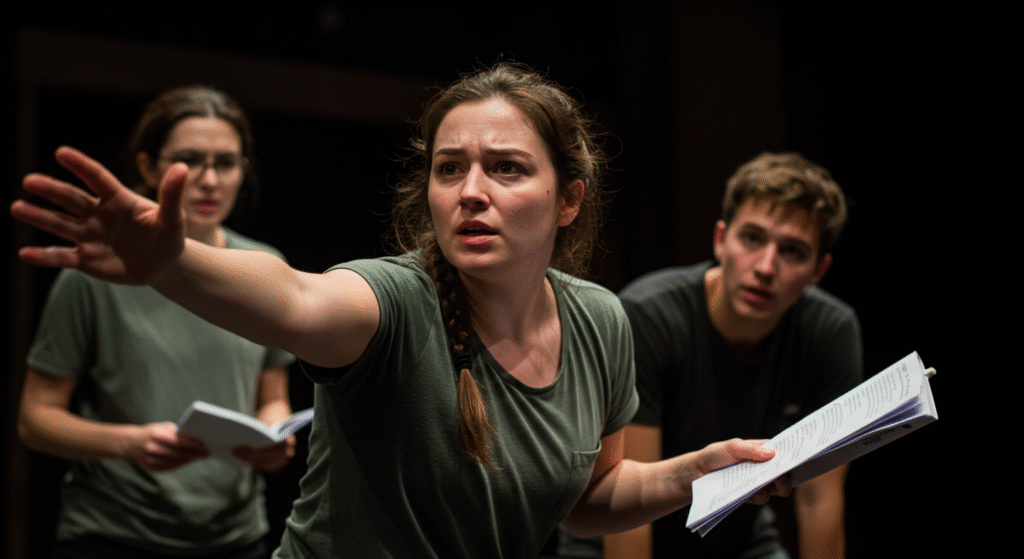
What It Is
The objective is what your character wants; the action (or tactic) is how they attempt to get it, moment by moment.
Why It Matters
Scenes become compelling when characters pursue clear goals through active behavior. Without objectives, actors wander; with them, stakes soar.
What You’ll Do in Class
- Script analysis worksheets identifying super-objective (overall) and scene objectives
- “Action verbs” lists—beg, threaten, flirt, provoke
- Re-playing a short scene, switching tactics every 10 lines to feel shifts
- Partner feedback on clarity and authenticity of each action choice
Quick At-Home Drills
While watching a favorite series, pause after each scene and jot the protagonist’s objective in one sentence (e.g., “convince the detective to drop the case”). Identify two tactics they used.
7. Given Circumstances Analysis
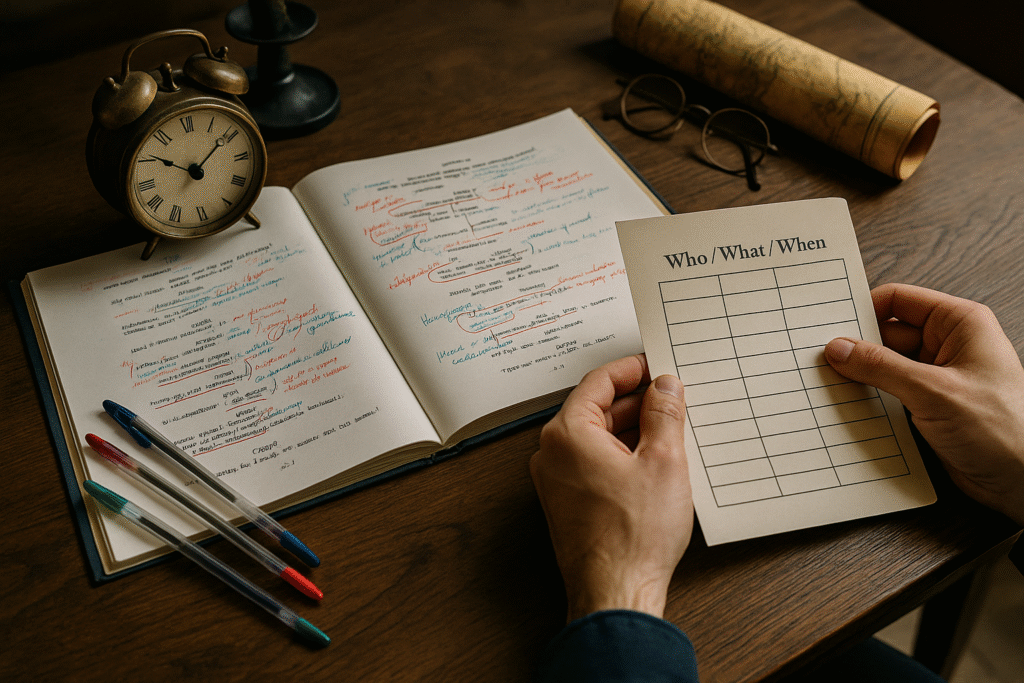
What It Is
Given circumstances are the facts supplied by the playwright—time period, location, social context, relationships, and prior events.
Why It Matters
Ignoring circumstances leads to generic choices. Honoring them generates layered performances anchored in the story’s reality.
What You’ll Do in Class
- “Who/What/Where/When/Why” charts for every scene
- Historical research assignments for period pieces
- Environment walks—acting a scene in a mock swamp, palace, or subway using sensory imagination
- Class discussions on how circumstances influence objectives
Quick At-Home Drills
Choose a monologue set in winter. Perform it twice: first imagining sub-zero temperatures, then a humid summer. Note how posture, breath, and pacing shift.
8. Character Development & Backstory

What It Is
Character development builds psychological depth; backstory fills in experiences that shaped the person you portray.
Why It Matters
Audiences sense when an actor knows who they are beyond the pages we see. Even one-line roles pop when rooted in backstory.
What You’ll Do in Class
- Hot-seat interviews—classmates ask questions while you answer in character
- “First memory” improvisations to discover formative events
- Journaling from the character’s point of view
- Physical experiments—altering gait, breath rhythm, or dominant hand
Quick At-Home Drills
Write a one-page diary entry as your character describing their biggest childhood secret. Read it aloud, exploring emotional subtext.
9. Scene Study & Beat Breakdown

What It Is
Scene study integrates all prior skills while beat breakdown divides the scene into units of action or emotional shift (beats).
Why It Matters
Identifying beats prevents monotony. Actors ride an intentional arc, sustaining tension and release that keeps viewers riveted.
What You’ll Do in Class
- “Slash and label” method—marking beat changes in the script
- Rehearsing one beat at a time to polish objectives
- Playing status shifts (who holds power) within each beat
- Instructor critiques on pacing and transitions
Quick At-Home Drills
Print a two-page scene. Underline every line where a new piece of information is revealed or a tactic changes. That’s a beat.
10. Active Listening & Reacting

What It Is
Active listening is fully receiving a partner’s words, tone, and body language; reacting means allowing genuine impulses to surface before responding.
Why It Matters
Great acting often lies in reaction shots—the flash of jealousy, wonder, or dread that flickers across a performer’s face. Listeners earn the camera close-ups.
What You’ll Do in Class
- Repetition exercises (Meisner) focusing on truthful response
- “Blindfold scenes” emphasizing vocal nuance over sight
- Silent scene runs, reacting with only facial expressions and gesture
- Partner improv where one line must spark an unpredictable answer
Quick At-Home Drills
Watch a talk show on mute. Describe aloud the silent guest’s emotional journey based solely on micro-expressions. You’ll sharpen perception and empathy.
11. Emotional Availability & Sense Memory

What It Is
Emotional availability is the capacity to access and express a wide spectrum of feelings. Sense memory (Stanislavski’s “affective memory”) uses remembered sensory details to trigger emotion.
Why It Matters
Audiences crave authenticity—not forced tears or anger. Techniques that safely access emotion deepen believability without self-harm.
What You’ll Do in Class
- Guided recall of personal sensory experiences (smell of rain on asphalt, taste of lemon)
- Partnered “emotion clock”—cycling through feelings on cue
- Physical triggers (music, colors, textures) to anchor states
- Debriefing on emotional hygiene and boundaries
Quick At-Home Drills
Peel an orange slowly, eyes closed. Let the fragrance flood memory. Immediately deliver an emotionally charged line, noticing how the scent colors delivery.
12. Improvisation Fundamentals
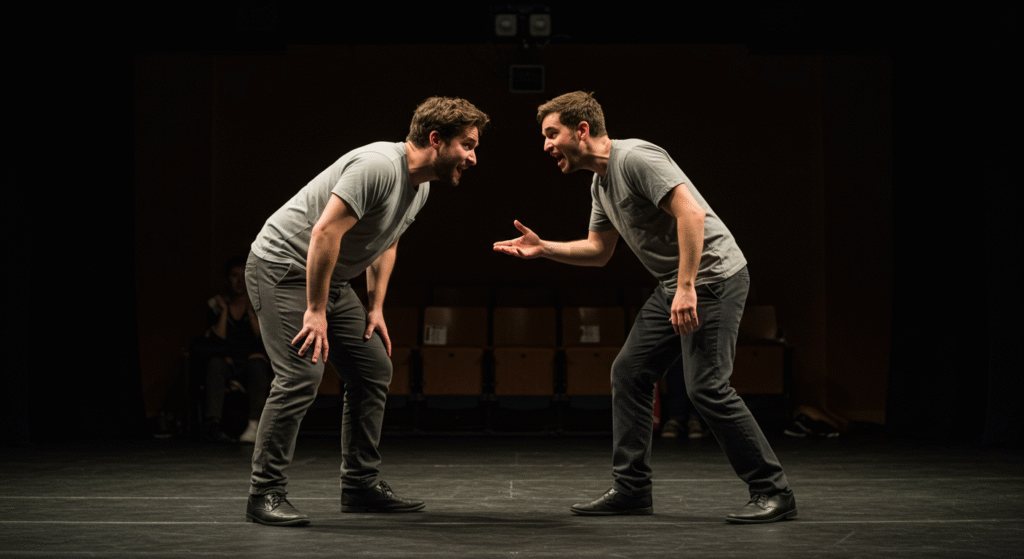
What It Is
Improvisation trains you to create dialogue, action, and character in the moment, without a script.
Why It Matters
Even scripted performances demand flexibility when props break or co-stars miss cues. Improv also boosts comedic timing and confidence.
What You’ll Do in Class
- “Yes, and” warm-ups to build agreement
- Status games (high vs. low) to explore power dynamics
- Gibberish scenes focusing purely on physical storytelling
- Long-form formats (Harold or Armando) to practice narrative arcs
Quick At-Home Drills
Stand in front of a mirror. Tell a 60-second story beginning with a random word from a dictionary page. Keep eye contact with yourself to heighten stakes.
13. Ensemble Collaboration
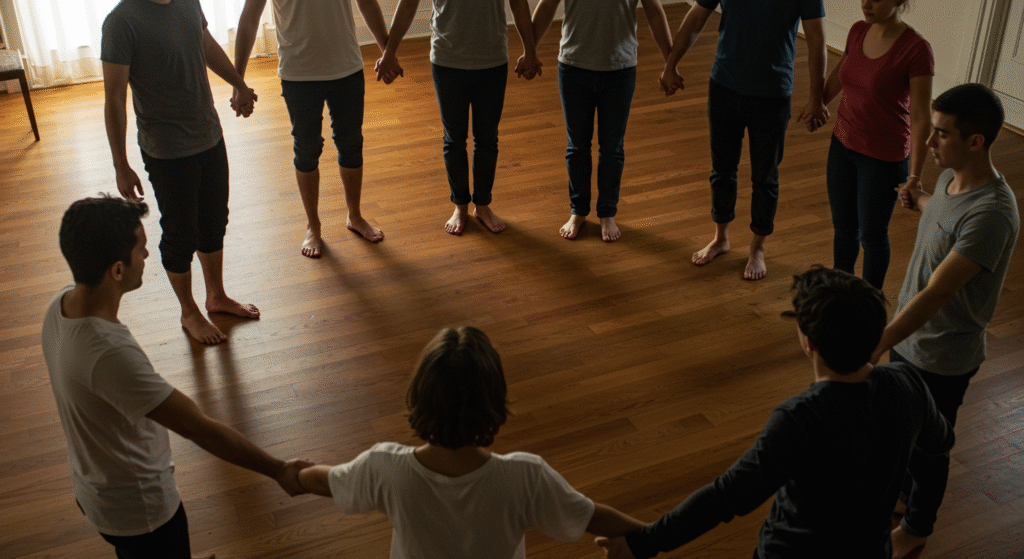
What It Is
Collaboration means functioning as part of an ensemble—listening, supporting, and sharing focus rather than competing for attention.
Why It Matters
The industry values actors who elevate the whole production, not just themselves. Ensemble skills lead to smoother rehearsals and stronger reviews.
What You’ll Do in Class
- Group movement pieces requiring synchronized breath and tempo
- Circle shares—rotating leadership in storytelling
- Trust exercises (e.g., controlled falls)
- Reflective feedback sessions cultivating constructive notes
Quick At-Home Drills
Play “Pass the Face” with friends or online: one person makes a facial expression; the next mirrors and morphs it into a new one, keeping flow continuous.
14. Audition Technique Basics

What It Is
Audition technique covers the etiquette and practical steps of presenting monologues or cold reads to casting directors.
Why It Matters
Landing roles keeps careers alive. Technical proficiency—slate, frame, eye-line, timing—distinguishes prepared actors from amateurs.
What You’ll Do in Class
- Mock auditions with immediate feedback
- Cold-reading drills—receiving sides, 10-minute prep, performance
- Self-tape lighting, framing, and sound workshops
- Intro to headshot, résumé, and casting software standards
Quick At-Home Drills
Record a 30-second slate on your phone: name, height, agency (or “self-represented”), and a fun fact. Review posture, energy, and framing.
15. Professional Discipline & Work Ethic
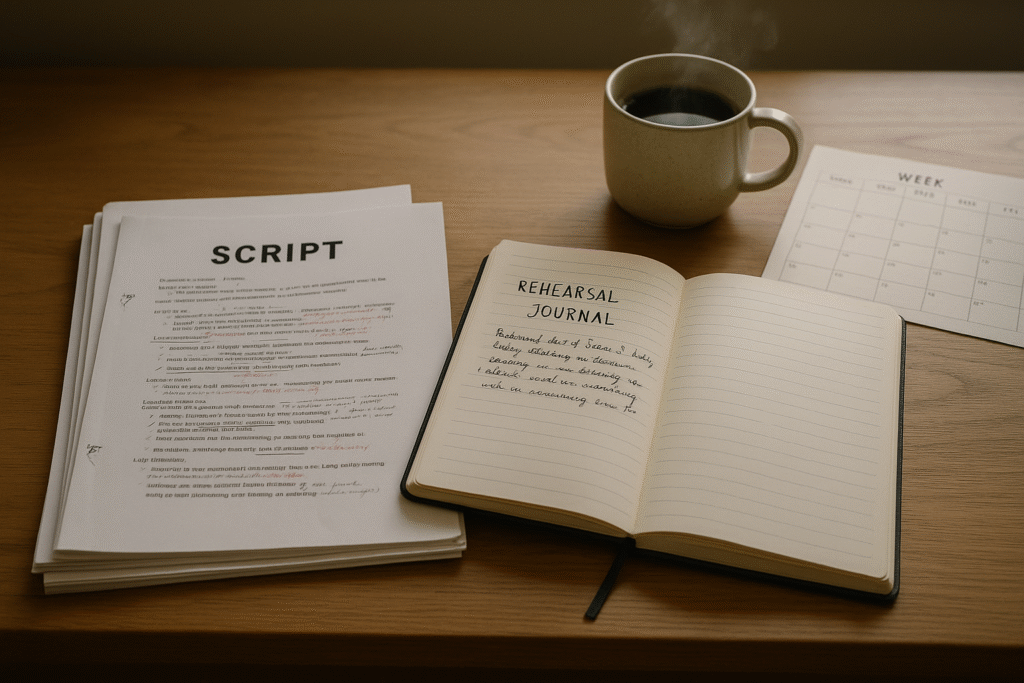
What It Is
Discipline encompasses punctuality, script memorization, note-taking, self-care, and respectful conduct. Work ethic underpins every above skill.
Why It Matters
Talent opens doors; reliability keeps them open. Directors rehire actors who learn lines early, show up focused, and contribute positively.
What You’ll Do in Class
- Line-learning deadlines with check-ins
- Rehearsal journals tracking progress and instructor notes
- Discussions on union guidelines, contracts, and set safety
- Time-management techniques—balancing day jobs, auditions, and classes
Quick At-Home Drills
Create a weekly planner dividing script study, physical warm-ups, and self-tape practice into 30-minute blocks. Stick to it for one month to cement habit.
Putting It All Together
During your first term, these 15 skills intertwine like strands of a rope. Breath control informs diction; relaxed muscles sharpen physical storytelling; clear objectives drive emotional availability; ensemble awareness enhances improvised scenes. Expect progress in uneven spurts—plateaus followed by breakthroughs. Celebrate small wins: a line landing cleanly, a genuine laugh from classmates, a teacher’s nod that you finally nailed a beat shift.
Tracking Your Growth
- Set SMART goals (Specific, Measurable, Achievable, Relevant, Time-bound)—e.g., “Hold a supported note for 18 seconds by week six.”
- Video journal one class per week. Observe voice, posture, and spontaneity changes over time.
- Seek outside feedback from peers not in your program to gauge readability of choices.
Common First-Term Challenges
| Challenge | Why It Happens | Pro Tip |
|---|---|---|
| Vocal fatigue | New breath patterns strain untrained muscles | Hydrate, steam, and rest 10 minutes per hour of speaking. |
| “Stuck in your head” | Overthinking objectives and tactics | Reset with a physical action—drop and do ten jump-squats. |
| Comparison to classmates | Mixed experience levels in most intro cohorts | Focus on measurable self-improvement rather than rankings. |
Frequently Asked Questions
Q: How many hours a week should I practice outside class? A: Conservatories recommend one to two hours of self-study per classroom hour. Consistency beats marathon cramming.
Q: Do I need prior experience to master these skills? A: No. Reputable beginner programs assume zero formal training. Coachability outweighs experience.
Q: Can online acting classes teach the same fundamentals? A: Yes—especially breath, diction, script analysis—but in-person work accelerates physical and ensemble learning.
Q: How soon will these skills translate to auditions? A: Expect noticeable improvements within three to four months, provided you practice diligently and seek audition opportunities early.
Final Thoughts
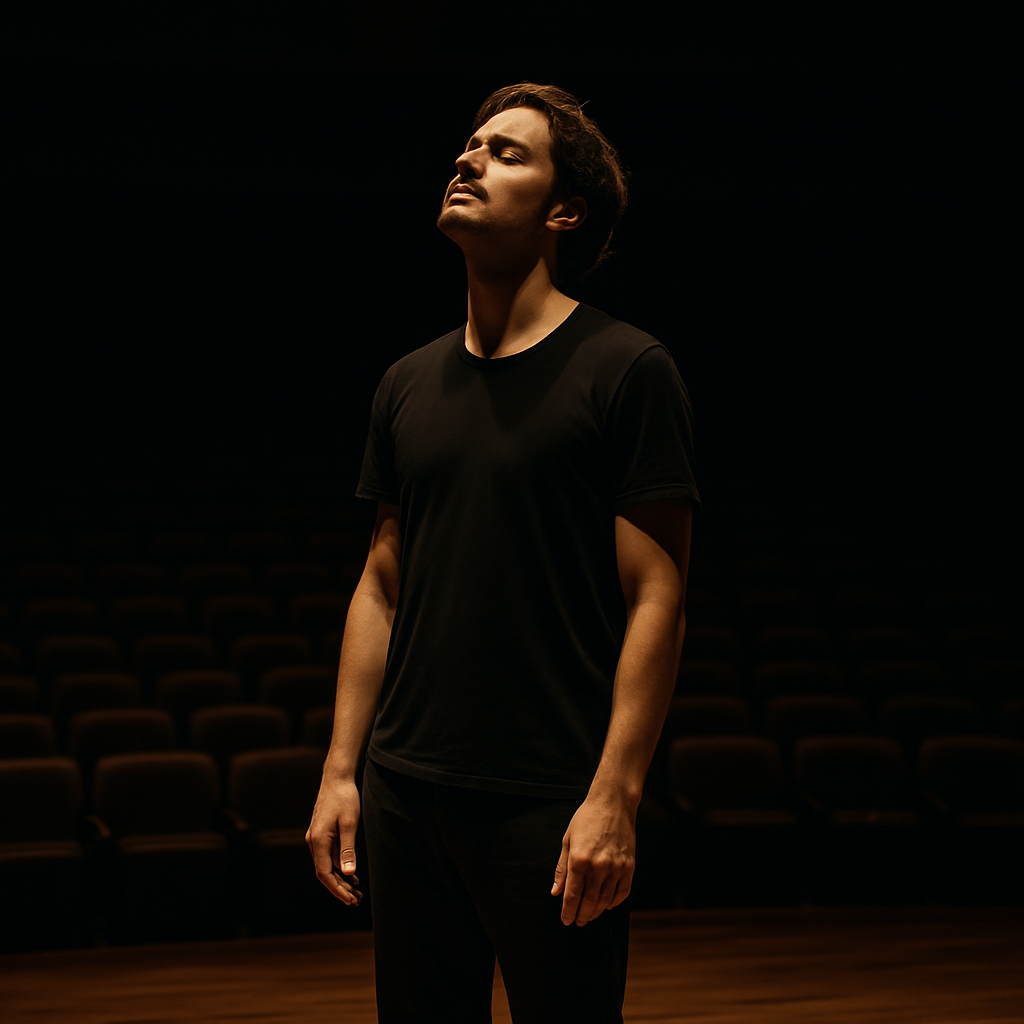
The first term of acting training is both structured boot camp and creative playground. You’ll sweat through vocal drills, laugh during wild improv, and maybe surprise yourself with emotions you didn’t know you could access.
By mastering the 15 essential skills outlined above, you lay a durable foundation for artistic growth, on-set professionalism, and lifelong communication savvy—whether your stage is a theater, a film set, or a boardroom presentation.
Stay curious, stay disciplined, and remember: every standing ovation begins with the simple decision to breathe, listen, and take action—truthfully, moment by moment.

